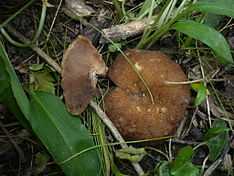Disciotis venosa
| Disciotis venosa | |
|---|---|
 | |
| Scientific classification | |
| Kingdom: | Fungi |
| Division: | Ascomycota |
| Class: | Pezizomycetes |
| Order: | Pezizales |
| Family: | Morchellaceae |
| Genus: | Disciotis |
| Species: | D. venosa |
| Binomial name | |
| Disciotis venosa (Pers.) Arnould (1893) | |
| Synonyms[1] | |
| |
Disciotis venosa, commonly known as the veiny cup fungus,[2] or the cup morel,[3] is a species of fungus in the family Morchellaceae. Fruiting in April and May, they are often difficult to locate because of their nondescript brown color. Found in North America and Europe, they appear to favor banks and slopes and sheltered sites. Although D. venosa is considered edible, it may resemble several other species of brown cup fungi of unknown edibility.
Description
Fruit bodies produced by this fungus are cup- or disc-shaped, up to 20 cm (8 in) wide. The interior surface of the cup, the hymenium, tends to become folded into vein-like markings, hence the specific epithet venosa. The exterior surface is a whitish color, covered with pustules. Although young fruiting bodies are cup-shaped, when they are 7 to 8 cm (2.8 to 3.1 in) in diameter, the apothecia split and flatten down to lie in the soil. They are very brittle. The fruit bodies have been estimated to have a lifespan of up to 12 weeks.[4]
Microscopic characteristics
The spore are elliptical and smooth, with dimensions of 21–24 by 12–14 µm. The asci (spore-bearing cells), are 370–400 by 18–20 µm, while the paraphyses are stout and club-shaped, with tips that are up to 12 µm wide.[2]
Edibility
Disciotis venosa is edible, and choice,[2] although one author notes that only collectors who have the equipment to check its microscopic characters should consider consuming the species, as it may be confused with several other brown cup fungi.[5]
Similar species
Species that may resemble Disciotis venosa include the "thick cup", species Discina perlata (also edible), as well as several species of Peziza. Peziza species generally have thinner flesh than D. venosa, and will turn a dark blue color if a drop of iodine solution is placed on it.[3]
Habitat and distribution
This fungus is typically found growing on the ground among mossy or needle-covered soil among conifers; they are often difficult to notice because their brown color typically blends into the background. They have been noted to prefer to grow on banks or slopes rather than flat areas.[4] This species is also referred to as a "snowbank mushroom" because fruit bodies typically appear around the edges of melting snowbanks.[6]
Disciotis venosa is found in North America[5] and Europe (including Sweden,[7] Spain,[8] and Wales[4]).
References
- ↑ "Species synonymy: Disciotis venosa (Pers.) Arnould, Bull. Soc. mycol. Fr. 9: 111 (1893)". Species Fungorum. CAB International. Retrieved 2014-01-03.
- ↑ 2.0 2.1 2.2 Tylutki EE. (1979). Mushrooms of Idaho and the Pacific Northwest. Moscow, Idaho: University Press of Idaho. p. 35. ISBN 0-89301-062-6.
- ↑ 3.0 3.1 McKnight VB, McKnight KH. (1987). A Field Guide to Mushrooms, North America. Boston: Houghton Mifflin. p. 37. ISBN 0-395-91090-0.
- ↑ 4.0 4.1 4.2 Brown RP. (1980). "Observations of Sarcoscypha coccinea and Disciotis venosa in North Wales during 1978–1979". Bulletin of the British Mycological Society 14 (2): 130–5. doi:10.1016/S0007-1528(80)80008-3.
- ↑ 5.0 5.1 Weber NS, Smith AH. (1980). The Mushroom Hunter's Field Guide. Ann Arbor, Michigan: University of Michigan Press. pp. 36–7. ISBN 0-472-85610-3.
- ↑ Arora D. (1986). Mushrooms Demystified: A Comprehensive Guide to the Fleshy Fungi. Berkeley, California: Ten Speed Press. p. 46. ISBN 0-89815-169-4.
- ↑ Ryman S. (1978). "Swedish Pezizales of spring and early summer". Svensk Botanisk Tidskrift 72 (4): 327–40.
- ↑ Losantos AP, Carretero JCB. (1981). "Mycologic notes on Navarra Spain 1. New provincial and peninsular records". Anales del Jardin Botanico de Madrid (in Spanish) 38 (1): 19–24.